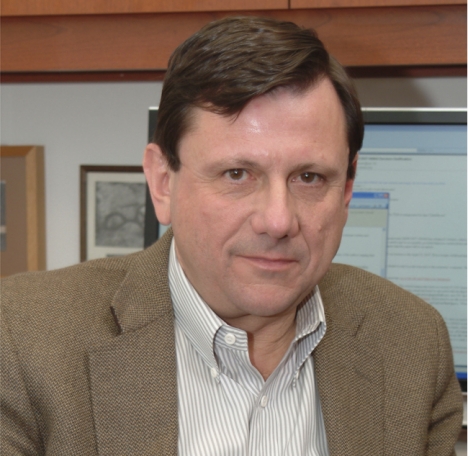Abstract
Early resistance to pathogens requires a swift response from NK cells. In 1989, Giorgio Trinchieri identified an NK growth factor and activator, later called interleukin-12 (IL-12). This discovery helped reveal the regulatory link between innate and adaptive immunity.
NK cells were discovered in the early 1970s and were immediately embraced by cancer researchers for their ability to spontaneously attack and lyse tumor cells (1). Over the next 10 years, the basic biology of these cells was worked out: where they lurked, how they recognized their targets, and how they killed. Despite this trove of information, how the cells grew in vitro and what signals activated them in vivo remained unknown.
Figure 1.
Giorgio Trinchieri
Growing killer cells
In the mid-1980s, researchers figured out how to isolate NK cells from peripheral blood mononuclear cells and maintain them in cultures containing the T cell-specific growth factor IL-2 (2). But these methods produced low numbers of NK cells and supported only short-term growth of NK cell clones.
Trinchieri and his team at the Wistar Institute in Philadelphia had found that a relatively large and pure population of NK cells could be generated by culturing mononuclear cells with irradiated B cell lines that had been immortalized by the Epstein-Barr Virus (3). They assumed that the dying B cells were secreting growth factors that favored NK cell proliferation. Cytokines such as IL-2, IL-1, IFNα/β/γ, and IL-6 were present in the cultures but could not support NK cell growth without B cells, suggesting that a direct cell–cell signal or an unknown growth factor was at work.
A novel cytokine
Although Trinchieri was intrigued by the identity of this potential growth factor, the primary interest of his team at that time was the ability of NK cells to regulate the differentiation of bone marrow stem cells. Trinchieri's team had discovered that NK cells inhibited the colony-forming ability of hematopoietic progenitor cells and induced their differentiation by secreting so-called “cytotoxic factors” and “colony-inhibiting factors” (4). The identification of TNF as the cytotoxic factor was easy since recombinant TNF protein was readily available. The team took longer, however, to purify lymphotoxin (LT), the putative source of the colony-inhibiting activity (5).
Michiko Kobayashi, a biochemist and purification expert on temporary loan from the Genetics Institute (Cambridge, MA), discovered IL-12 during her efforts to purify LT. She had generated massive quantities of supernatents from B cell cultures for this project. She and Trinchieri reasoned that this soup might also contain NK cell growth factors. Using standard chromatography based separation techniques, she fractionated the cell-free supernatents and tested each eluted fraction for its ability to induce the three known functions of NK cells: IFNγ production, cytotoxic activity against tumor cell lines, and enhanced proliferation in response to mitogens.
The sole fraction that tested positive for all three functions was purified and proven to be a potent NK cell stimulator. The NK-stimulating factor, as the mystery protein was called before it was renamed IL-12, was composed of 30- and 40-kD covalently bound subunits, and was the first heterodimeric cytokine to be described. The team published their discovery in The Journal of Experimental Medicine in 1989 (6). “We would have never found IL-12 if it hadn't been for our efforts to purify LT or for Michiko's refusal to waste that supernatant,” says Trinchieri. “It was our bonus result.”
A regulatory bridge
IL-12 has since gained fame as something of an immunological busybody. In collaboration with researchers at the DNAX Research Institute (Palo Alto, CA), Trinchieri later showed that the IL-12 produced by dendritic cells induced naive CD4+ T cells to differentiate into T helper (Th)-1 cells (7), adaptive immune cells that respond to infectious agents and cancer antigens. The ability of IL-12 to promote an early nonspecific response via NK activation and IFNγ production and a late specific response via Th1 differentiation allows it to link innate and adaptive immune mechanisms. Treatment with IL-12 abolishes mouse tumors and prevents tumor establishment. This success has generated much interest in using IL-12 in human anti-tumor therapies. But IL-12-induced Th1 cells have a dangerous flip-side: they drive the pathogenesis of many autoimmune disorders. IL-12 is currently under investigation as a therapeutic target for these diseases (8).
References
- 1.Rosenberg, E.B., et al. 1972. Int. J. Cancer. 9:648–658. [DOI] [PubMed] [Google Scholar]
- 2.Timonen, T., et al. 1982. Cell. Immunol. 72:178–185. [DOI] [PubMed] [Google Scholar]
- 3.Perussia, B., et al. 1987. Nat. Immun. Cell Growth Regul. 6:171–188. [PubMed] [Google Scholar]
- 4.Degliantoni, G., et al. 1985. J. Exp. Med. 162:1512–1530. [DOI] [PMC free article] [PubMed] [Google Scholar]
- 5.Trinchieri, G., et al. 1986. J. Exp. Med. 164:1206–1225. [DOI] [PMC free article] [PubMed] [Google Scholar]
- 6.Kobayashi, M., et al. 1989. J. Exp. Med. 170:827–845. [DOI] [PMC free article] [PubMed] [Google Scholar]
- 7.Macatonia, S.E., et al. 1995. J. Immunol. 154:5071–5079. [PubMed] [Google Scholar]
- 8.Trinchieri, G. 2003. Nat. Rev. Immunol. 3(2):133–146. [DOI] [PubMed] [Google Scholar]



